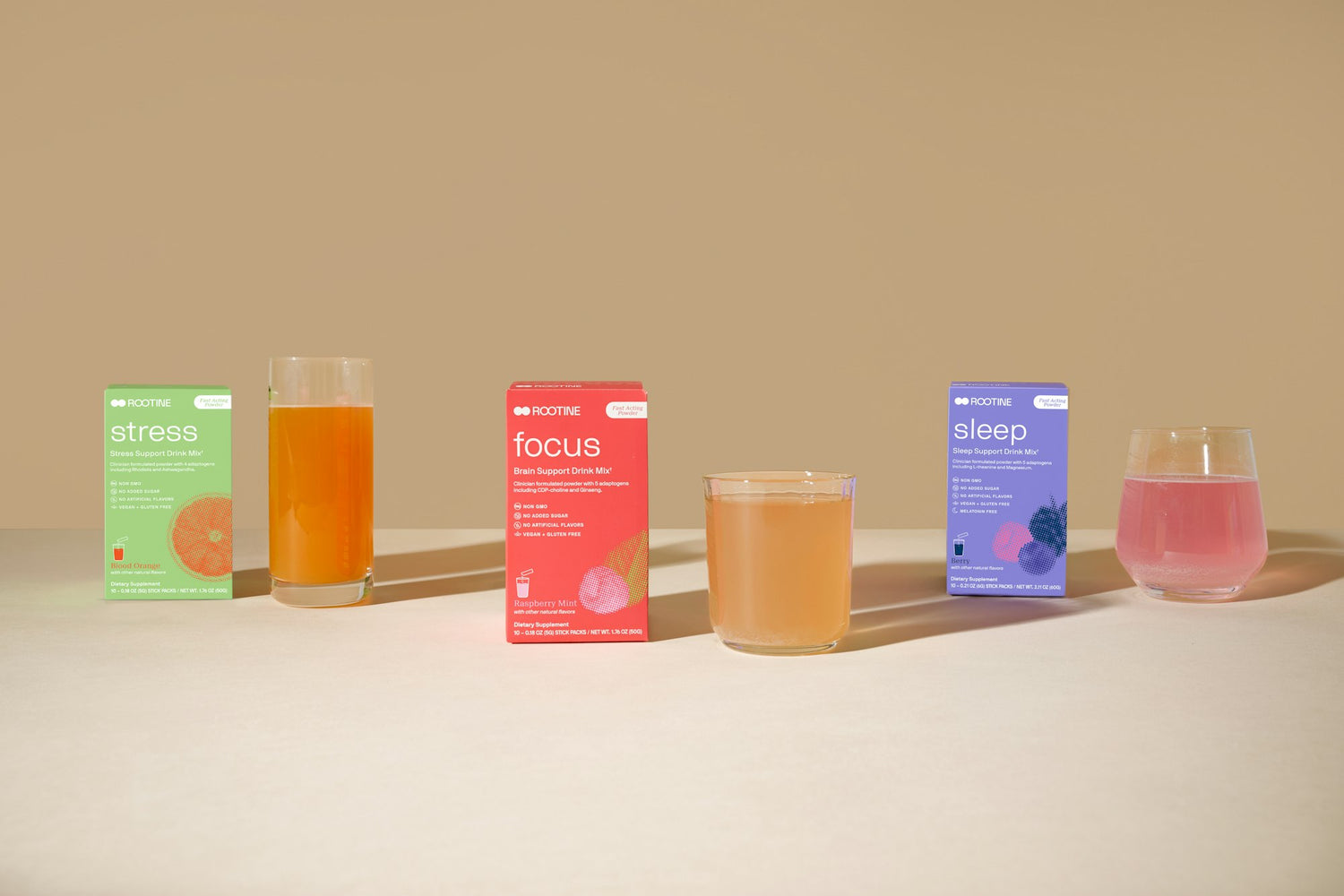What are hormones
Hormones are chemical messengers that regulate many processes in the human body. They are known as signaling molecules because they circulate through the blood stream to various tissues and signal cells to perform their functions. Essentially, they tell the body what to do and when to do it.
Endocrine system
Hormones are primarily produced and released by glands, a system known as the endocrine system. This endocrine system controls bodily processes like metabolism, blood pressure, blood sugar, body temperature, growth and development, sexual function, sleep, mood, reproduction, and electrolyte balance.
What affects hormone production
Factors like diet, sleep quality, light exposure, exercise, genetics, stress, alcohol consumption, exposure to endocrine disruptors, caffeine, and smoking can all affect hormone levels, for better or worse.
Symptoms of hormonal imbalance
There is a long list of physical, mental, and emotional signs that can indicate a hormone imbalance: mood swings, irritability, weight loss or gain, trouble losing weight, insomnia/sleeping problems, fatigue, acne, infertility, decreased sex drive, heavy periods, irregular periods, hair loss, and hot flashes.
These symptoms stem from fluctuations in hormones that are larger than the natural fluctuations women experience throughout their cycle.
Unfortunately, hormone imbalances are quite common in modern society. Statistics show about 80% of women suffer with hormone imbalance [1]. With lots of processed food options, endocrine disrupting chemicals everywhere, and stress levels at an all-time high, it’s no shock more people are looking for ways to balance things out.
Key hormones to look at
Although we have many hormones, progesterone and estrogen are important to look at.
Progesterone
Progesterone regulates ovulation and menstruation. It also supports bone health and increases metabolic rate, which boosts energy and appetite.
Progesterone levels normally fluctuate during your cycle, but too low of progesterone could be causing problems. Low progesterone is associated with stronger PMS symptoms, irregular periods, infertility, headaches, low libido, depression and anxiety.
Compounding this issue, progesterone and estrogen “naturally balance each other out”, and not producing enough progesterone causes estrogen dominance.
Estrogen
Estrogen is made by the ovaries and controls reproductive and sexual development. It also impacts mood and brain structure. Estrogen levels are important to keep an eye on; high estrogen is the cause of breast cancer and other unwanted complications.
Estrogen imbalances
Estrogen dominance, when the ratio of estrogen to progesterone is high, can cause heavy periods, headaches, low libido, bloating, mood swings, breast tenderness, anxiety, depression, endometriosis, and hormonal weight gain.
Estrogen dominance can be caused by low progesterone, changes in estrogen metabolism and excretion, or an overproduction of estrogen by the body [4].
Conditions due to chronic hormone imbalance
Several conditions can result from imbalanced hormones.
Diabetes mellitus
Diabetes mellitus is associated with too much cortisol. It’s caused by insulin resistance, when the body doesn’t regulate blood sugar effectively. This causes blood sugar, or glucose levels, to increase and either insulin is unable to uptake the glucose or the pancreas doesn’t produce enough insulin to begin with. Regardless, blood sugar stays elevated which can damage nerves, blood vessels, and vital organs.
Cushing’s syndrome
Cushing’s syndrome is another condition associated with excess cortisol being released by the adrenal glands. This is commonly caused by taking an oral corticosteroid, which increases cortisol production.
PCOS
PCOS, or polycystic ovarian syndrome, is the formation of small cysts (fluid filled sacks) on the ovaries and affects women’s menstrual cycle, skin, weight, and hair growth. It occurs when the ovaries produce an abnormal amount of androgens, a male sex hormone. The high level of androgens prevent ovulation and eggs are never released from the ovaries.
Thyroid disorders
Thyroid disorders are characterized by either an under-functioning thyroid (hypothyroidism), when your body produces not enough of certain thyroid hormones, or an over-functioning one (hyperthyroidism), when too many hormones are produced.
Hormone fluctuations over the month
Here's a quick overview of the natural monthly fluctuations a women experiences throughout her cycle.
Cycle phases
There are four phases: menstrual, follicular, ovulation, and luteal [3].
Menstrual phase
The first phase, the menstrual phase, starts on the first day of your period. Up until this point, hormone levels have been increasing in the body and the uterus has spent the month building a thick uterine lining to best support the potential growth of a fertilized egg.
But since the egg was not fertilized (joined with sperm), estrogen and progesterone levels drop which triggers the shedding of the uterine lining, called the endometrium, and results in bleeding.
This typically lasts for three to seven days. Menstrual cramps, bleeding, and bloating are commonly reported during this time. Prostaglandin, a compound similar to a hormone, causes the uterus to spasm to help shed the lining which results in cramps. It’s normal to feel more tired during this time and require additional rest. Avoiding caffeine can be helpful as well since caffeine affects hormone levels and constricts blood vessels.
Follicular phase
The second phase, the follicular phase, begins on the first day of your period and ends with ovulation. FSH, follicle stimulating hormone, stimulates the ovary to produce an egg. During this time, estrogen and testosterone levels start to build. With the rise of hormones comes the rise of energy and most women report feeling much better during this phase than during menstruation. The release of the egg from a follicle in the ovary begins ovulation.
Ovulation
Ovulation is when the ovary releases a mature egg and it travels down the fallopian tube towards the uterus. At the start of ovulation, luteinizing hormone (LH) rises to signal to the ovary to release the mature egg. Testosterone and estrogen are also at their peak during this phase. Due to high hormone levels, skin breakouts, headaches, water retention, and weight gain can occur.
If the egg isn’t fertilized within 24 hours, it will dissolve and this phase ends.
Luteal phase
The last phase begins right after ovulation and lasts for the rest of the cycle, until menstruation. Progesterone continues to increase at this time to prepare the uterus for pregnancy. Body temperature can actually raise almost half a degree.
If you get pregnant, your body embarks on a whole new hormone adventure. But for when you don’t get pregnant (no egg implants into the uterine lining), progesterone begins to decline. The increased estrogen levels paired with the now declining progesterone can cause mood imbalances and affect serotonin levels. “PMS” symptoms are thought to be caused by low levels of progesterone.
How to support optimal hormone function
Diet
Diet is arguably the most important factor in hormone regulation. Blood sugar stabilization and adequate nutrient intake provide a solid base to support healthy female hormones.
Blood sugar stabilization
Eating meals that keep blood sugar stable is important. Incorporating proteins and healthy fats at each meal can minimize the spike that carbohydrates cause as well as help you feel fuller for longer.
Insulin regulation
Blood sugar stabilization is important because continual glucose and insulin spikes lead to insulin resistance, when cells stop responding well to insulin and can't use glucose in the blood for energy.
Insulin resistance increases estrogen levels by increasing aromatase (an enzyme involved in synthesizing estrogen) activity, which results in the increased conversion of testosterone into estrogen. Insulin resistance also decreases sex-hormone-binding globulin, which leads to greater amounts of free circulating estrogen [5].
Fiber
Fiber from whole foods helps stabilize blood sugar and helps you feel full after eating. It also increases the amount of estrogen excreted [6]. Researchers have found that women who eat a high amount of fiber have lower estrogen levels.
Adequate nutrient intake
Getting adequate amounts of hormone balancing nutrients in your diet improves every aspect of health.
Vitamins
The endocrine system needs magnesium, B vitamins, omega-3 fatty acids, vitamin D, and zinc.
Magnesium
Magnesium not only reduces stress and helps the body relax, but it promotes healthy estrogen clearance and lessens insulin resistance.
It supports the COMT (catecholo-methyltransferase) enzyme, which works in your liver to excrete excess estrogen [7]. In hormone imbalances with estrogen dominance, magnesium can be an important natural supplement in the treatment process.
It also has been shown to help PMS symptoms like period cramps and migraines. With period cramps, magnesium helps relax the smooth muscle of the uterus and decreases prostaglandins, the compound that stimulates uterine contractions [8].
With insulin resistance, five clinical trials have proved magnesium plays a role in glucose metabolism and lowers insulin resistance values [9].
Food sources of magnesium
Dark leafy greens, chia, flax, and pumpkin seeds, legumes, and dark chocolate are great sources of magnesium.
Magnesium supplementation
To support hormonal health, a magnesium supplement is usually necessary as you need a higher dose than is found in foods. A high quality vitamin supplement is a great option for those with magnesium deficiency. Rootine's supplements are lab tested to ensure the highest quality product and can be the first step in improving your health.
Supplementing with magnesium can benefit everyone, not just those with hormone imbalances. Since magnesium supports muscle relaxation, our bodies naturally get rid of magnesium when we’re stressed. This makes sense evolutionary (in caveman times of immediate stress we needed to increase alertness) but in modern days chronic stress can lead to magnesium deficiencies.
Vitamin B
B vitamins are known as the “energy vitamin” due to helping the body transform food into energy but they’re also important with hormonal health.
B6
B6 Supports the production of progesterone, and since many women have low progesterone and high estrogen, increasing progesterone is key.
B5
B5 is important in the production of steroid hormones, such as estrogen and progesterone.
B2
B2 is also required for the thyroid to function properly; low levels of B2 suppress thyroid function and leads to decreased hormone production by the thyroid and adrenal glands.
Omega-3s
Omega-3 fatty acids are an essential fat the body doesn’t make on its own. They have a few different kinds: EPA (eicosapentaenoic acid) and DHA (docosahexaenoic acid) are the fatty acids in fish and ALA (alpha-linolenic acid) is the omega-3 fat found in plants.
These compounds have been shown to decrease inflammation, raise HDL or “good” cholesterol, lower triglyceride levels, and improve overall cardiovascular health.
Improve blood sugar
They also stabilize blood sugar which is important in hormone balance because a stable blood sugar minimizes large glucose and insulin spikes. Those large spikes in blood sugar are what causes insulin resistance, so getting the spike under control is the first priority when looking at balancing out hormones.
Vitamin D
The sunshine vitamin, vitamin D, is critical for not only bone building but hormone balance as well. Vitamin D deficiency has been linked to insulin resistance, estrogen imbalance, lowered immune system, and brittle bones.
Improves insulin resistance
Vitamin D reduces insulin resistance “through its effect on calcium and phosphorus metabolism and through up regulation of the insulin receptor gene”. This means that vitamin D makes the insulin receptors more sensitive. In a study with almost 6,000 participants, vitamin D supplementation increased insulin sensitivity by 54% [10].
Higher levels of vitamin D may maintain estrogen balance and are useful in treating conditions associated with estrogen dominance. It’s been shown to improve symptoms such as weight gain, PCOS, and irregular menstrual cycles.
It’s also linked to the production of serotonin and dopamine which can improve anxiety, depression, and overall mood [11].
Zinc
Zinc plays a critical role in the endocrine system. Zinc promotes ovulation by nourishing the ovarian follicles. It also supports thyroid function; zinc has to be present in order for the thyroid hormone, thyroxine, to be converted to tri-iodothyronine.
Zinc also helps regulate the effect of insulin. It stabilizes and stores insulin in pancreatic tissue and has been shown in two recent studies to lower blood glucose, LDL “bad” cholesterol, and triglycerides [12].
Other ways to support hormones
All in all, you can’t balance out hormones with a bad diet. Getting enough of all the essential vitamins and minerals and eating foods that support blood sugar balance are pillars of hormone health.
Prioritize sleep and avoid xenoestrogens
Other factors like adequate sleep and minimizing exposure to endocrine disruptors can also help. Xenoestrogens are compounds that imitate estrogen in the body and are linked to estrogen dominance. Xenoestrogens are found in our water system, plastics, pesticides, and chemicals.
Many cosmetic and body care products have this compound in them and it’s important to be mindful of what you’re putting on your body as the skin absorbs anything you put on it. Using glass instead of plastic, drinking filtered water, buying organic produce, and using cleaner cosmetic brands are small changes you can make to support balanced hormones.
Sources
1. 11 Unexpected Signs of Hormone Imbalance . Northwell Health. (2018, November 27). Retrieved May 21, 2022, from https://www.northwell.edu/obstetrics-and-gynecology/fertility/expert-insights/11-unexpected-signs-of-hormonal-imbalance
2. All about hormonal imbalance in women. Hormonal Imbalance in Women: What is Hormonal Balances. (2021). Retrieved May 21, 2022, from https://www.crystalrunhealthcare.com/articles/all-about-hormonal-imbalance-in-women
3. Natale, N., & Jio, S. (2021, November 2). Ovulation hormones: Here's how the menstrual cycle phases affect your mood. Woman's Day. Retrieved May 21, 2022, from https://www.womansday.com/health-fitness/womens-health/a1605/a-month-in-the-life-of-your-hormones-107587/
4. Kolan, A. (2018, July 24). Estrogen Dominance . Go to VA.gov. Retrieved May 21, 2022, from https://www.va.gov/WHOLEHEALTHLIBRARY/tools/estrogen-dominance.asp
5. Warshowsky A. Uterine Fibroids. In: Rakel D, ed. Integrative Medicine. 4th ed. Philadelphia: Elsevier Saunders; 2018:578-591.
6. Low Dog T, Micozzi M. Women’s Health in Complementary and Integrative Medicine: A Clinical Guide. St Louis, MO: Elsevier Churchill Livingstone; 2005.
7. Briden, L. (2021, January 5). Magnesium and the menstrual cycle. Clue Period & Ovulation Tracker with Ovulation Calendar for iOS, Android, and watchOS. Retrieved May 21, 2022, from https://helloclue.com/articles/cycle-a-z/magnesium-and-the-menstrual-cycle
8. Parazzini F et al. Magnesium in the gynecological practice: a literature review. Magnes Res. 2017 Feb 1;30(1):1-7.
9. Morais JBS et al. Effect of magnesium supplementation on insulin resistance in humans: A systematic review. Nutrition. 2017 Jun;38:54-60.
10. Talaei, A., Mohamadi, M., & Adgi, Z. (2013, February 26). The effect of vitamin D on insulin resistance in patients with type 2 diabetes - diabetology & metabolic syndrome. BioMed Central. Retrieved May 21, 2022, from https://dmsjournal.biomedcentral.com/articles/10.1186/1758-5996-5-8
11. Yoo, B. (2018, December 13). The benefits of vitamin D. Ali Miller RD. Retrieved May 21, 2022, from https://www.naturallynourishedrd.com/the-benefits-of-vitamin-d/
12. Pattalis , E. (2019, July 17). How zinc can balance hormones. Elizabeth Pattalis Nutritionist. Retrieved May 21, 2022, from https://elizabethpattalis.com/zincbenefits/



